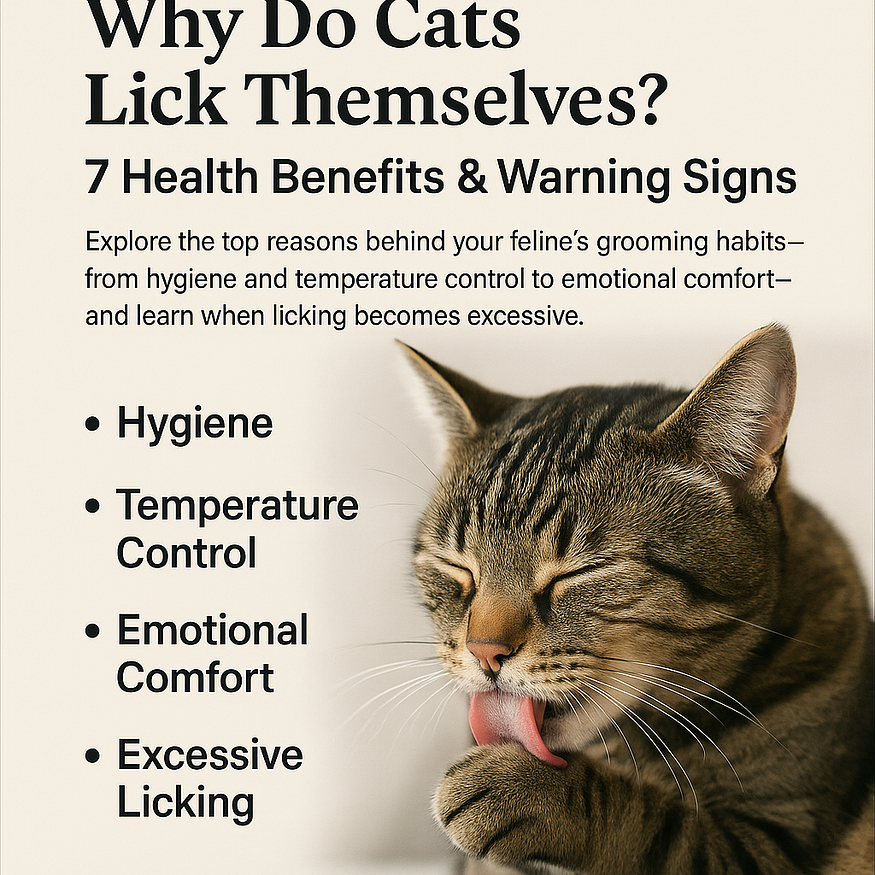Explore the top reasons behind your feline’s grooming habits — from hygiene and temperature control to emotional comfort — and learn when licking becomes excessive

This post can be read on Medium
Written by Xena
Introduction
We who keep cats as pets witness their self-grooming every day. Cats devote two to five hours daily to grooming, using their rough tongues to remove excess hair, dirt, and parasites, keeping their coats smooth and healthy.
This entirely natural behavior serves hygienic purposes and helps regulate body temperature, distribute skin oils, and stimulate circulation. Cat owners should learn to distinguish normal grooming from excessive licking, which can signal stress, health issues, or environmental discomfort.
Anatomy of the Tongue and Hygiene
A cat’s tongue is covered in tiny projections called papillae, which act like miniature combs to scrape away debris and work saliva deep into the fur. As the saliva evaporates from the coat, it not only cleans but also cools — an important function, since cats lack widespread sweat glands.
Removal of Dirt and Parasites
By licking, cats effectively rid themselves of fleas, ticks, and other ectoparasites, reducing the risk of infestation and skin irritation. They also remove loose hair before it tangles and forms mats.
Temperature Regulation and Skin Health — Evaporative Cooling
Licking causes moisture in the saliva to evaporate, carrying heat away from the body. In effect, a cat has its own natural “air conditioner,” helping to maintain optimal body temperature on hot days.
Improved Circulation
The massaging action of the tongue stimulates blood flow to the skin, aiding nutrient delivery and waste removal at the microvascular level, supporting overall health and skin renewal.
Social and Emotional Components
Territory Marking and Scent
Cats have scent glands on their head, cheeks, and paws. By spreading saliva enriched with pheromones over their fur and surroundings, they mark territory and create a familiar scent profile that calms and comforts them.
Stress and Boredom Reduction
Licking promotes the release of endorphins — natural “feel-good” hormones — helping cats cope with stress, boredom, and changes in their environment. However, excessive licking (more than five hours per day) or targeted licking that leads to bald patches may indicate stress, allergies, or pain and requires veterinary attention.
Signs of Excessive Licking and When to Seek Help
- Hair Loss: Sudden patches of missing fur can point to dermatitis, allergies, or parasites.
- Redness and Inflammation: Irritated, red, or scabbed skin can be worsened by over-licking.
- Behavioral Changes: Increased licking at certain times of day or after changes in household routines may signal psychological distress or pain.
If you notice these signs regularly, consult your veterinarian. Early treatment of allergies, infections, or stress can prevent long-term health problems for your pet.
Conclusion
Self-grooming is an instinctive behavior essential to a cat’s health. By understanding why cats lick themselves and observing their habits closely, combined with regular veterinary check-ups, you can ensure your feline friend remains happy, healthy, and impeccably groomed.
https://www.catdogwrld.com/2025/02/cat-safety-alert-hidden-risks-of.html

Feel free to contact me if you need a writer
If you want to support my work, buy me a coffee for $1 by clicking the link below. This is a small amount for you, but this means a lot to me!
Greetings, and until my next article!
Xena













0 comments:
Post a Comment